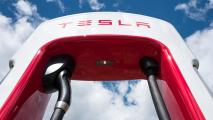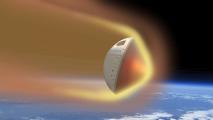This article is an installment of Future Explored, a weekly guide to world-changing technology. You can get stories like this one straight to your inbox every Thursday morning by subscribing here.
The fastest commercial jet today travels at about 680 miles per hour, but an Atlanta-based startup is developing a hypersonic plane that would carry passengers at least 3,800 mph — five times the speed of sound (Mach 5).
If the company can bring its concept to fruition, it could change the world — but can superfast flight ever be affordable?
Why it matters: The main benefit of hypersonic planes is that they’d mean less time in the air — today, you’ll spend seven hours flying from New York City to London on a commercial jet, but on a hypersonic plane, you’d be able to make the trip in just 90 minutes.
“Hypersonic aircraft are truly game-changing and will revolutionize how we travel.”
Heather Pringle
For tourists, this could mean replacing a day of flying with a day of sightseeing. For business travelers, it could mean catching a flight in the morning, meeting with an international client in person for lunch, and being home in time for dinner with the family.
“When it comes to technology, we often hear the term ‘game-changing,’” Heather Pringle, commander of the Air Force Research Laboratory, said in a press release. “However hypersonic aircraft and propulsion systems are truly game-changing and will revolutionize how we travel, just as automobiles did in the last century.”
The challenge: The major hurdle to commercial hypersonic flight isn’t getting a plane up to that speed — planes have safely carried people faster than Mach 5 before — but doing so while keeping costs low enough that travelers would be willing to buy tickets.
The supersonic Concorde (which only flew below Mach 2) never managed to do that. The average roundtrip transatlantic flight (adjusted for inflation) was about $12,000, and that high cost contributed to the plane’s demise.

One way for hypersonic plane developers to manage costs is to keep the plane as light as possible, cutting down on the amount of fuel needed to fly it.
But the powerful rocket engines propelling previous hypersonic planes require an oxidizer (usually a tank of liquid oxygen), which can add a lot of weight to the plane.
A type of air-breathing engine — one that pulls oxygen from the atmosphere rather than an onboard tank — called a ramjet can propel a plane to hypersonic speeds, too, but it has trouble working at low speeds.
One workaround is to attach your hypersonic plane to another aircraft, and once that plane is moving fast, you can release the hypersonic plane and fire up the ramjets. But bringing a second plane into the mix — one that needs to lift the weight of two aircraft — isn’t efficient, either.
The idea: Hypersonic plane startup Hermeus thinks the key to keeping costs down will be combining a ramjet with a traditional turbojet engine — what’s known as a “turbine-based combined cycle” (TBCC) propulsion system.
The idea is that the turbojet could power the plane during takeoff from a runway. The powerful ramjet would then kick in for the middle portion of the flight, and the turbojet would take over again to handle the landing.
“The turbojet portion and the ramjet portion by themselves are mature technologies that we’ve been using for 50 years,” CEO AJ Piplica told CNN. “The trick is to put them together, so we designed our own architecture around an off-the-shelf turbojet engine and then built out from there.”

Planes with TBCC systems have flown before — the US military’s SR-71 spy plane is one example — but no one has ever used this type of propulsion system in a commercial passenger aircraft.
Some investors believe that Hermeus could pull it off — in July 2021, the US Air Force invested $60 million in the startup, and in March 2022, Hermeus raised another $100 million, led by Sam Altman, former president of start-up accelerator Y-Combinator.
“Hermeus is pursuing an ambitious vision that seems impossible at first glance, but they pair it with an engineering culture and business roadmap that can actually bring it into reality,” said Altman.
The next steps: Hermeus expects to have its first prototype plane — Quarterhorse — ready for flight by 2023. After that, it’ll move on to building one called Darkhorse.
“Quarterhorse is a sprinter, effectively the smallest possible airframe to flight test our engine, Chimera, across all modes of operation and Mach numbers,” COO Skyler Shuford told CNBC. “Darkhorse will be capable of sustained hypersonic flight and be able to carry cargo or payloads.”

All of that will be the preamble to the company’s 20-seater hypersonic plane: Halcyon.
“To help us size the aircraft, we basically built a business model for an airline,” Piplica said. “We focused on the business class and first class travelers, and then played around with some parameters such as speed and operating costs.”
“We expect it to be profitable at today’s business class prices,” he added, but noted that “you can’t really answer that question until there’s a product out there and you have the real data.”
Because regulations still make it illegal to travel in excess of supersonic speeds over land, Halcyon may be limited to flying transatlantic routes (and its expected range of about 4,000 nautical miles isn’t enough for transpacific routes).
But it’s also possible that the FAA will revise its rules to take account of today’s quieter supersonic technology, replacing the speed limit with a noise restriction.
“We expect Halcyon to be profitable at today’s business class prices.”
AJ Piplica
The big picture: Hermeus isn’t the only company hoping to dramatically speed up passenger flight.
Texas startup Venus Aerospace is developing a spaceplane it says will be able to get people from one side of the globe to the other in an hour — however, that plane would be powered by rocket engines, and the company hasn’t said what it expects tickets to cost.
SpaceX has also said it wants to use its massive in-development Starship rocket for hypersonic travel around the globe. The per-flight cost of those trips could be spread out over nearly 1,000 passengers, potentially leading to tickets as cheap as $1,200.
Even if commercial hypersonic flight isn’t viable, that doesn’t mean we’ll be stuck at today’s jet speeds forever — one of the many companies developing supersonic planes far more efficient than the Concorde could cut down on travel times.
We’d love to hear from you! If you have a comment about this article or if you have a tip for a future Freethink story, please email us at tips@freethink.com.






